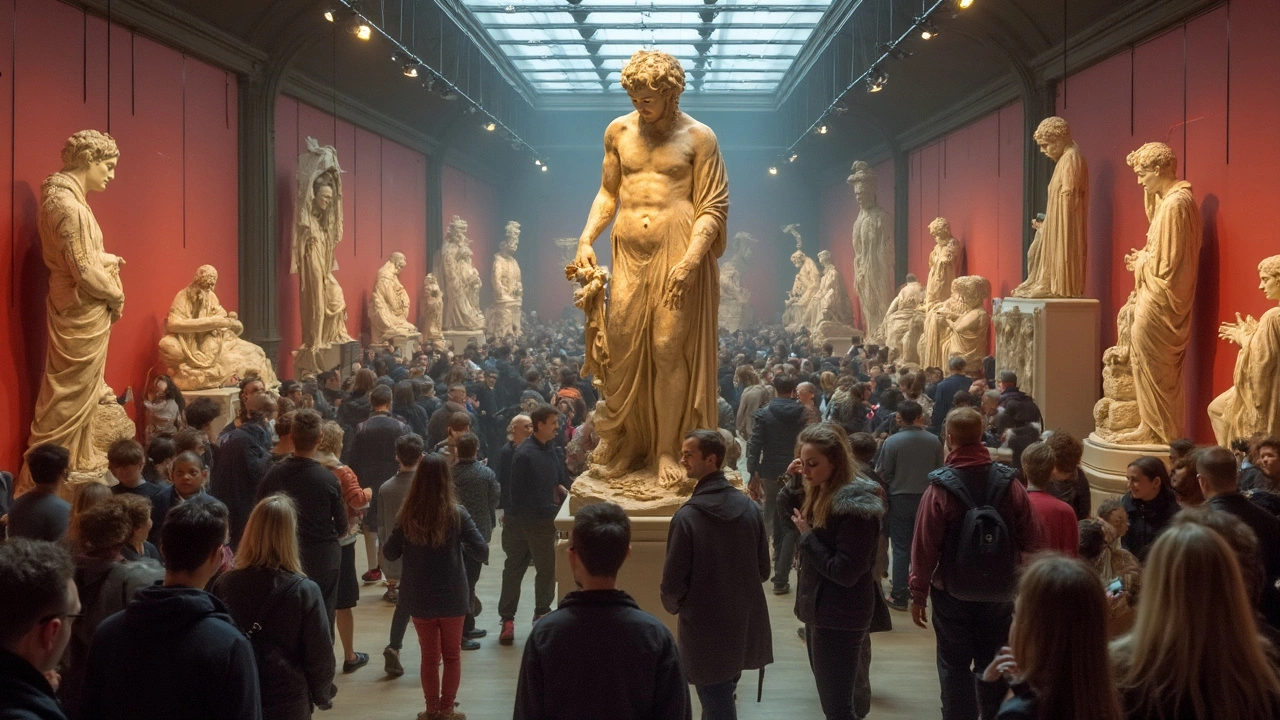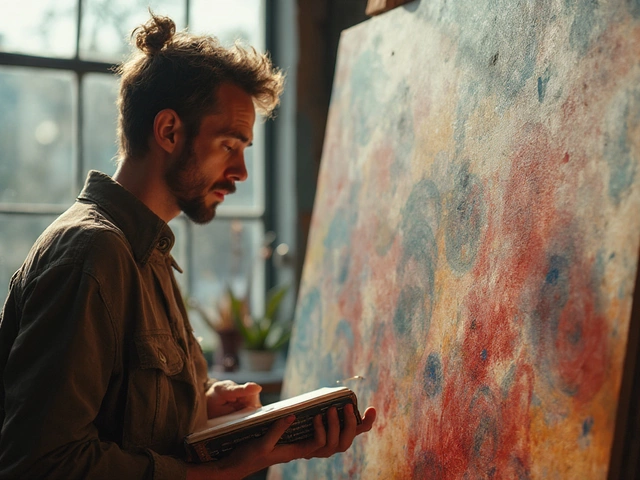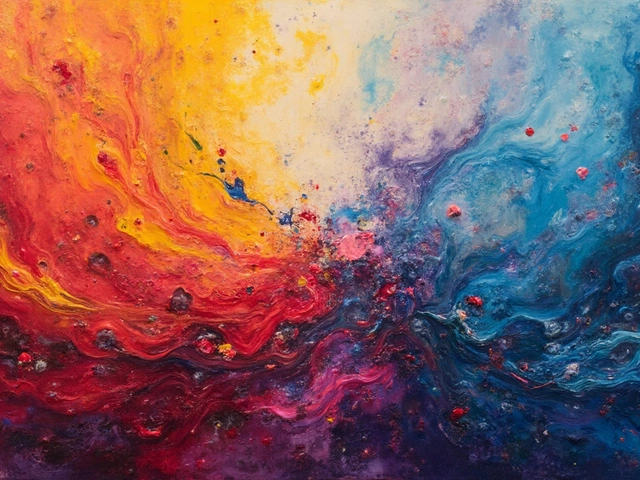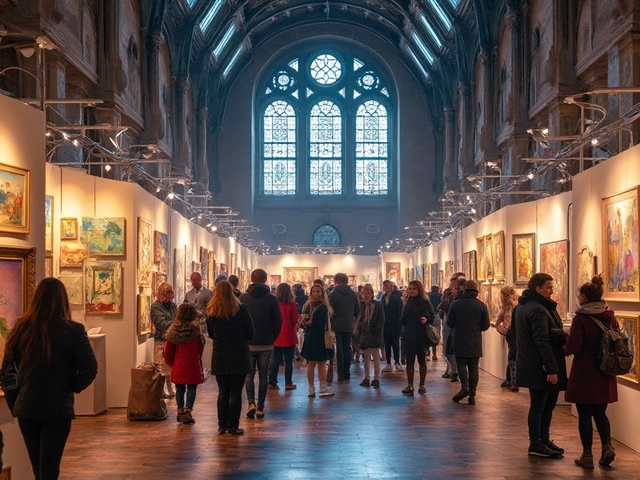Ever stared at an object in a museum and wondered, “Wait, is that even a sculpture?” You’re not alone. The line between sculpture and other art forms gets blurry, especially when you toss in stuff like installations, mixed media, and 3D-printed art. Here’s the deal: sculpture, at its core, is about three dimensions. If an artwork physically takes up space—you can walk around it, look at it from different angles, and maybe even trip over it—chances are, you’re looking at a sculpture.
This isn’t just about marble figures and bronze heroes on horseback. Artists carve, build, weld, and stick together everything from wood to plastic toys to create sculptures. Materials are wide open. Even ice and light can count, as long as the work stands in real space and interacts with it. A painting, for example, will always be stuck on the wall (no matter how thick the paint gets). Sculpture fights for its own spot in the room.
- Defining Sculpture: It’s More Than Just Statues
- Materials and Techniques: Beyond Marble and Bronze
- Dimension and Space: The 3D Requirement
- Boundaries with Painting, Architecture, and Other Arts
- What’s NOT a Sculpture? Common Misconceptions
- Tips for Recognizing and Appreciating Sculptures
Defining Sculpture: It’s More Than Just Statues
If someone says "sculpture" and you picture a marble figure from ancient Rome, you’re in good company. But the truth is, sculpture goes way beyond classic statues. The biggest clue? Sculpture deals with three dimensions—height, width, and depth. This means a sculpture lives in your space, not just on a wall.
The word "sculpture" comes from the Latin 'sculpere' which means to carve. That’s only part of the story now. Sure, there are traditional methods like carving and modeling clay, but artists now use welding, casting, 3D-printing, even found objects like scrap metal or LEGO bricks to shape their ideas. There's no single rule about what a sculpture has to look like.
So, what officially slides an artwork into the sculptural category? Let’s break it down:
- Sculpture must be three-dimensional. You should be able to walk around it or view it from at least a couple of different sides.
- Usually, a sculpture doesn’t have to hang flat on a wall or be framed. It stands or sits on its own, whether that’s a pedestal or the floor.
- Materials are flexible—stone, glass, plastic, old tools, even food. If it can hold a shape, it’s fair game.
- The intention matters. If the artist made it to exist as a three-dimensional form, that’s sculpture, even if the end result isn’t "statue-like."
Just to give you a sense of how broad the definition runs, check out this quick table. These examples show how sculptures have shifted through different eras and styles.
| Era/Type | Example Work | Material | Reason It’s Sculpture |
|---|---|---|---|
| Ancient Greece | Venus de Milo | Marble | Free-standing, 3D, carved |
| Modernism | Picasso’s "She-Goat" | Bronze, scrap metal | Assembled, occupies space |
| Contemporary | Damien Hirst’s animals in tanks | Formaldehyde, glass | Real objects in three-dimensional context |
| Conceptual | Rachel Whiteread’s "House" | Concrete | Cast negative space of an entire house |
What links all these works isn’t their subject or how realistic they look. It’s that they all claim space in the real world, force you to move around them, and make you think about form in a physical way. Next time you see a pile of weirdly shaped material in a gallery, ask yourself: Is it three-dimensional? Can I look at it from different angles? If yes, you’re probably dealing with sculpture, not just a fancy decoration.
Materials and Techniques: Beyond Marble and Bronze
People usually think of marble and bronze first when they hear the word sculpture, but honestly, that's just scratching the surface. Walk into any major gallery and you're going to see sculptures made out of wood, steel, plastic, glass, fiber, and even recycled junk. The modern scene has thrown out the old rulebook about sticking to precious materials.
The way artists work with these materials varies a ton. Traditional methods like carving (chipping away at stone or wood), casting (pouring stuff like molten bronze into a mold), and modeling (shaping clay or wax by hand) are still going strong. But now there’s also welding, 3D printing, and found object art. For example, artist Louise Nevelson built giant walls out of old furniture. Jeff Koons made balloon animals out of polished stainless steel. These pieces are unmistakably sculptures, just not your grandma’s kind.
Certain materials give sculptures their personalities. Wood is warm and organic, while steel feels cold and industrial. Artists often mix things up, combining several materials in one piece—think of those large outdoor works you see outside museums, using concrete, metal, and sometimes living plants.
Here’s a quick snapshot of some main sculpture materials and how they’re used:
| Material | Common Techniques | Famous Example |
|---|---|---|
| Marble | Carving | Michelangelo's David |
| Bronze | Casting | Rodin's The Thinker |
| Wood | Carving, Assembly | Louise Nevelson’s Sky Cathedral |
| Steel | Welding, Fabrication | Richard Serra’s Tilted Arc |
| Plastic | Molding, Assembly | Jeff Koons’ Balloon Dog |
If you want to try making a sculpture yourself, start simple. Clay is cheap and easy to model. Found objects are everywhere (old tools, scrap metal, even kitchen gadgets). Don’t worry about using traditional materials unless you absolutely want that classic look. What matters is how you shape it, and how it interacts with real space.
Dimension and Space: The 3D Requirement
If you had to lock down one sentence for what makes something a sculpture, it’s that it exists in three dimensions. That means sculptures have height, width, and depth—they push out into real space where you can actually see around them, not just at them. Art history books will tell you: paintings and drawings are stuck to a surface; sculptures occupy the world like we do.
Museums don’t just draw this line out of habit. Even the earliest cave carvings from 35,000 years ago showed people thinking in 3D. Think about Michelangelo’s "David": it’s not just the look of the stone, but the fact that you can circle around it, experience it from every view, and feel like it shares your space. That’s what trips people up—this isn’t just about showing something, it’s about placing something real, right in the room with you.
“Sculpture is the art of the intelligence.” — Pablo Picasso
This 3D thing isn’t just tradition. Recent numbers from the International Sculpture Center show that more than 70% of professional sculptors today work in mediums that require a full 360-degree view—meaning, you have to walk around them or at least see multiple sides to get the piece.
| Art Type | Dimensions | Viewer Interaction |
|---|---|---|
| Painting | Height, Width | Front view only |
| Sculpture | Height, Width, Depth | Multiple angles, 360° |
| Relief | 2.5 Dimensions | Partial side views |
Quick tip: next time you see a piece and you’re not sure if it’s a sculpture, just ask yourself—can you walk around it and does it hold its own as a physical object? If yes, you’re probably dealing with real-deal sculpture art. Even wall-mounted works can count, but only if they build out into the room and give you that sense of presence—not just a decorated surface.
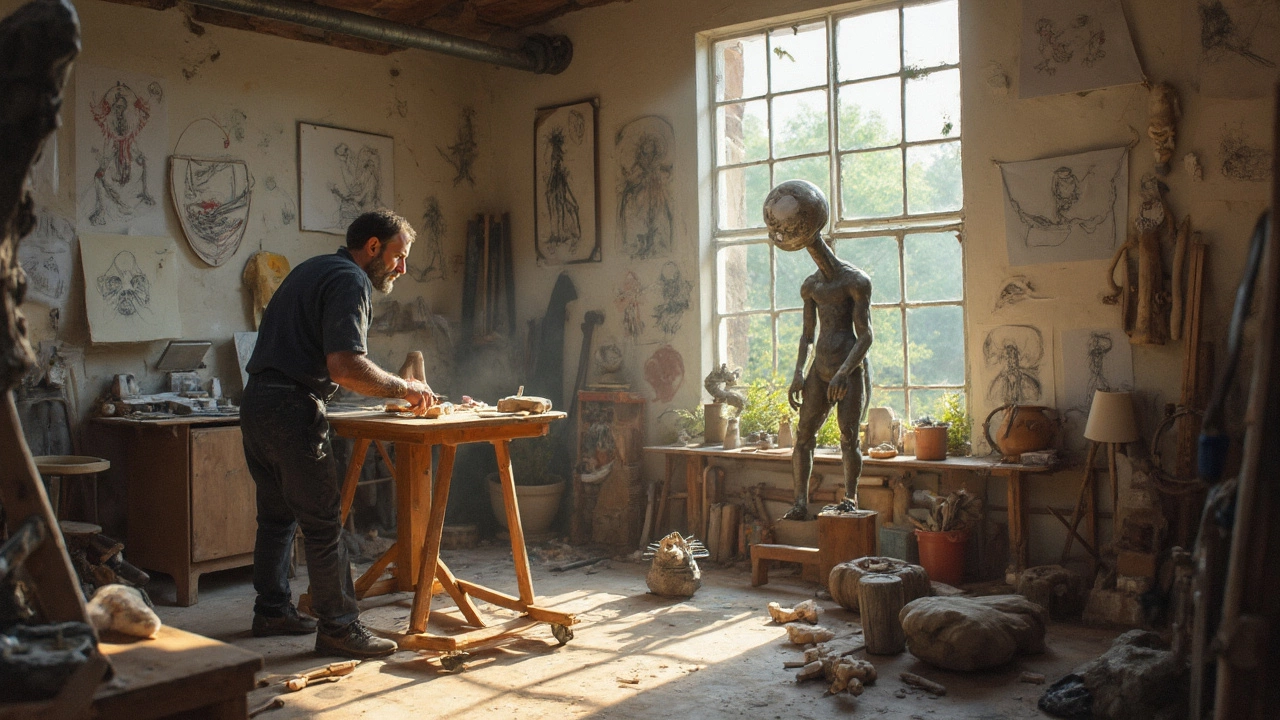
Boundaries with Painting, Architecture, and Other Arts
This is where things get tricky. Sometimes, an artwork blurs the lines so much you have to look twice. The key difference? Sculpture always breaks out from the wall, but painting usually stays flat. Paintings are two-dimensional—think canvas or paper. They play with color, line, and texture, but not real space. Yet, in the 20th century, some artists started piling materials on their canvases or shaping thick swirls of paint, and suddenly folks wondered if those should count as sculptures. The art world calls these “reliefs”—they stick out, but not enough to stand alone like proper sculptures.
On the flip side, architecture is full-on three-dimensional, just like sculpture, but it’s about spaces you can live or work in. If you can enter it or it’s designed mainly for people to use, it’s probably architecture. Frank Gehry’s wild, wavy buildings draw on sculpture for inspiration, and sometimes architects get called “artists” themselves. But the difference sticks: buildings are for shelter and everyday function; sculptures just have to stand on their own as art.
Still confused? Here’s a quick way to sort them out:
- Sculpture: Three-dimensional, stands alone, not made for practical use, with the main goal to be experienced as art.
- Painting: Two-dimensional, usually hangs on a wall, focuses on visual effects.
- Architecture: Three-dimensional, large-scale, built for people to use (live, work, gather in).
Artists started pushing boundaries in the last century. People like Robert Rauschenberg made “combines” in the 1950s—basically hybrid pieces, part sculpture, part painting, using found junk, paint, and everyday stuff. Then you have installation art, like Yayoi Kusama’s mirror rooms or Damien Hirst’s display cases—these bend the rules and make everyone question what counts as sculpture, painting, or even architecture sometimes.
Check out this quick comparison table that summarizes the main differences:
| Art Form | Main Feature | Main Function | Classic Example |
|---|---|---|---|
| Sculpture | 3D, Free-standing | Art/Expression | Rodin – The Thinker |
| Painting | 2D, Flat Surface | Visual Art | Da Vinci – Mona Lisa |
| Architecture | 3D, Usable Space | Shelter/Function | Frank Lloyd Wright – Fallingwater |
If you want to judge an artwork, think about how it sits in space and if it’s meant for everyday use. That usually sorts things out quickly.
What’s NOT a Sculpture? Common Misconceptions
There’s a lot of confusion out there when it comes to what actually counts as a sculpture. Just because something looks artsy or pops out from a surface doesn’t mean it’s a sculpture. Let’s clear up some popular mix-ups that trip people up all the time.
- Paintings with thick layers: If you see a painting with loads of chunky, textured paint sticking out (think Van Gogh on steroids), that’s still a painting, not a sculpture. If it’s hanging flat against a wall and isn’t meant to be seen from all sides, it doesn’t count.
- Reliefs: These are those carvings or images raised off a flat background, like what you find on coins or the sides of old buildings. They’re a sort of “half-sculpture,” but since you can’t walk around them and see the back, the art world sees them as something a bit different from true sculptures.
- Functional objects: This covers things like fancy chairs, clocks, or designer furniture. Even if they look wild and creative, if their main aim is to be used (sit, tell time, store cookies) instead of just being art, that puts them outside proper sculpture territory.
- Architecture: A beautifully designed building might feel like a huge piece of art, but it’s still architecture, not sculpture. The main purpose of a building is always use and shelter, even if it’s stunning to look at.
- Installations and performance art: These can get confusing. Installations sometimes feature objects that are sculptures, but if the whole point is the environment, lighting, or a temporary setup, and not a single crafted object, it leans more toward installation or performance art, not classic sculpture.
If you want to see some real distinctions in action, check out this table comparing different art forms. It breaks down their key differences so you can sound like you know what you’re talking about next time you’re at a gallery:
| Art Form | Freestanding | Main Purpose | Seen from All Sides? |
|---|---|---|---|
| Sculpture | Yes | Art/Object | Yes |
| Relief | No | Art/Decoration | No |
| Painting | No | Art | No |
| Furniture | Maybe | Use/Object | Not usually |
| Installation | Maybe | Experience/Environment | Sometimes |
The next time someone points at a weird piece of art and calls it a sculpture, you’ll know whether that label actually sticks. Just remember, for something to be a sculpture, it’s gotta be a sculpture: fully three-dimensional, mainly made for its own sake, and not just a background or prop for something else.
Tips for Recognizing and Appreciating Sculptures
Spotting a sculpture isn’t rocket science, but there are some easy tricks to help you get it right. Most sculptures live in three dimensions, meaning you should be able to walk around them or view them from all sides. Flat art, like a photograph or a painting, won’t give you that experience.
Check the material. If it’s wood, stone, metal, clay, glass, or a mix of stuff like wires, everyday objects, or even recycled trash, it’s probably a sculpture if it’s holding its own shape in space. Artists have been known to use everything from LEGO to balloons, and as long as the work exists off the wall, it qualifies as sculpture in most museums.
It helps to ask questions like these when you’re looking at any artwork:
- Can I walk around it, or is it stuck to a wall?
- Does it use any unusual materials or techniques?
- Is it trying to make me feel or think something, or is it just showing off technique?
- How does light and shadow play off the piece? (This is a huge part of sculpture experience.)
When you’re trying to appreciate a sculpture, don’t just stand back and stare. Change your perspective—walk around if you can. Look for details from different angles. Museums spend a lot of time on lighting because the way light hits a sculpture totally changes how it looks and feels. For example, Michelangelo’s David is carved so even subtle shadows give it more muscle definition, no matter how the sun hits it.
If you’re curious about trends or popular materials, here’s a snapshot from a 2022 survey by the Sculpture.org network about material use in major exhibits:
| Material | % Used in Major Exhibits (2022) |
|---|---|
| Bronze | 29% |
| Wood | 22% |
| Mixed Media | 18% |
| Stone | 14% |
| Other (Plastics, Found Objects, etc.) | 17% |
One last thing—don’t worry about “getting” every sculpture at first sight. Sometimes, artists are just experimenting, pushing boundaries, or making statements you don’t catch right away. Give yourself permission to ask questions, look closer, and even google wild pieces later. That’s how your appreciation grows over time.
